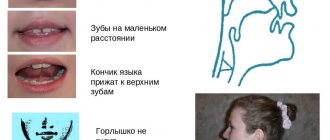Speech plays a big role in life for every person. Inconvenience and difficulty in communication can be caused by various speech defects. Therefore, it is so important to promptly notice your child’s incorrect pronunciation and take action. Producing the “C” sound is not particularly difficult. With the right exercises and regular practice, you can quickly achieve success. How to do this?
The importance of making a whistling sound
Making sounds in speech therapy is a special process that represents the development of the skill of pronunciation of a particular letter. It is important for a child to learn to reproduce sound in any form, depending on the word and the combination of letters in it.
Speech therapists often encounter speech disorders precisely when reproducing whistling sounds in children. There are two types of such defects:
- sigmatism;
- parasigmatism.
In the first case, the baby distorts the pronunciation of the correct sound “S” or “S”, and in the second, he completely changes them to other sounds.
Therefore, it is so important to notice a speech disorder in a child in time and begin to instill the skill of correctly reproducing letters. Such pathologies can also negatively affect the nervous system of children and lead to the following diseases:
- Dysgraphia. It represents various disorders of written speech, when a child involuntarily changes letters in places while writing, replaces them with other letters, and so on.
- Dyslexia. This pathology does not allow the child to read normally, making it difficult to connect letters into a single text.
- Dislalia. With this disease, children have serious defects in the pronunciation of certain sounds.
Thus, there is no doubt that sound production is important and mandatory. Parents should be patient and choose effective speech development methods for their children, breaking them down into certain stages, from simple to complex.
Reasons for violations
One of the reasons for the appearance of sigmatism is a violation of articulation. It may be due to anatomical features, for example, malocclusion. Then you need to visit an orthodontist. Or it could be the presence of adenoids that need to be removed.
Violations of sound pronunciation C can be caused by the following features of the articulatory apparatus:
- weak muscle tone of the tongue;
- tremor of the tip of the tongue.
The absence or impairment of pronunciation C may be a manifestation of dyslalia (simple and complex forms) or be part of more complex speech disorders: dysarthria, rhinolalia, alalia. Based on the cause of the violations, the speech therapist draws up a plan for corrective work.
Preparatory activities
Staging whistling sounds first begins with training the child's breathing. He must be able to release a jet of air with force. To do this, you can ask him to take air into his mouth and blow strongly through the tube from his lips. You can use cotton wool or something else light, place it on a flat surface and blow it away over some distance. Or you can come up with a competition to see who can blow away the ball of cotton wool next. This will make it more interesting for the child to complete the task.
It is also a good idea to carry out various exercises that develop the breathing process. You can perform the following tasks:
- "Harmonic". Stand up straight, place your hands on your stomach with your palms, inhale deeply through your nasal cavity and hold your breath for a couple of seconds. Then you should exhale using your mouth. This exercise will help you exhale more forcefully and learn how to correctly direct the air stream.
- "Breeze". Extend your lips with a straw, draw in air and blow strongly through it. In this case, you need to place your palm in front of your mouth, which should feel a sharp cool stream of air.
- "Storm". Take a bottle with a narrow neck. Bring it to your lower lip and blow. A characteristic noise will indicate the correct direction of the air stream.
After doing the breathing exercises, you will need to articulate the sound. It helps a person to train the muscle tissue of the speech apparatus, to practice the skills of the correct arrangement of organs during the pronunciation of a particular sound.
To make a hard “S” or a soft “S” sound, you can use the following tasks:
- "Naughty tongue." You need to smile, open your mouth a little. Place your tongue on your lower lip and slap your lips against it, pronouncing the syllable “five” several times. Do this for one inhalation, and then fix the tongue in a passive state on the lip for a few seconds. At the same time, you can calmly exhale air. You need to make sure that the lower lip is not tucked in or pulled under the jaw. Also, the sides of the speech organ should touch the corners of the oral cavity.
- "Crap". You need to open your mouth and smile. Place the front part of the tongue on the lower lip and fix it in this state for a few seconds. In this case, you should not strain your lips, stretch them wide, tuck them in or pull them over the lower jaw. Also, do not stick out your tongue too much; it should only cover the lip, and its sides should touch the corners of the mouth.
- "Mountain". You need to open your mouth and smile. Then, with the wide tip of the speech organ, rest against the tubercles that are located behind the lower jaw. Next, you should raise the middle part of the tongue until it touches the upper incisors, and then lower it. When performing the exercise, you need to make sure that the tip of the tongue does not come off the tubercles, and that all other organs of the speech apparatus remain motionless.
First, you need to conduct simple classes, then gradually add more complex tasks. The main thing is that this is done regularly and with the desire to achieve success in producing whistling sounds. You can find more detailed information about articulation exercises in our article - articulatory gymnastics for the sound “C”.
In order for the pronunciation of the sound “C” to be correct, you need to control the position of the organs of the speech apparatus, as well as the breathing process while reproducing the letter.
After preparing the organs, you can proceed directly to the exercises.
Staging sound using imitation
Imitation is the easiest and most preferable way to produce sound. Children like to repeat after adults and animals, so using this exercise to make the sound “C” will interest them.
To do this, you need to sit with your baby in front of the mirror and demonstrate to him the correct position and movement of the speech organs while pronouncing the hard sound “C” and softening it. Then ask him to repeat the same thing. You can also ask the child to show how the wind blows, how a pump inflates a tire, and so on.
How to set sound mechanically?
Techniques for producing sounds include mechanical methods. To do this you need to do the following:
- Smile widely, place your wide tongue between your teeth. In this case, its tip should be located only on the lower jaw. It is necessary to ensure that the baby does not press the organ with his upper teeth.
- Then ask the baby to blow on the tip of the tongue so that it feels cool. You can bring your hand to your mouth and feel the exhaled air stream.
- While the baby is blowing on the tip of the tongue, you need to place a toothpick on its midline, pressing slightly on it. Thus, a “groove” is formed, along which a stream of air will then flow. You need to insert the toothpick about 2 cm.
- Ask the child to blow. During this, a fuzzy hissing whistle will be heard. Then you will need to close your jaws so that only a toothpick fits between them, and your tongue remains inside. You also need to continue to blow on the tip of the tongue, the stream should be interdental. When the jaws close, a whistle is produced that cannot be interrupted.
- While the baby is making a whistle, you need to press the toothpick on the tongue with varying force and move it back and forth. This will allow you to determine in what position the sound “C” sounds correct.
- Once this position has been established, you can further practice pronunciation. When the child says the letter “C” correctly, you need to slowly remove the toothpick from the baby’s mouth.
- For some period of time it will continue to correctly reproduce whistling sounds without this device, but then it may go astray again. Therefore, it is necessary to train in this way until the child is able to correctly set the desired position of the speech organs.
- You can consolidate the results of this exercise by pronunciating syllables and words. If it becomes more difficult for the baby to reproduce the sound as part of a word, then you can again use the mechanical method.
A set of articulation exercises
Differentiation of whistling patients is based on the performance of exercises that the speech therapist selects individually. Among the most effective are the following:
- It is necessary to open your mouth wide in a smile without closing your teeth. After a few seconds, you can relax your lip muscles. The exercise is repeated 5-6 times.
- The starting position is the same as in the previous exercise. You need to run the tip of your tongue along the gums, simulating brushing. First, attention is paid to the upper teeth, then to the lower teeth.
- The mouth stretches into a smile, after which the tip of the tongue should touch the corners of the lips one by one. The chin should be motionless at this moment.
- The tongue protrudes as much as possible. First, it must be pulled to the tip of the nose, and then to the chin. After this, you should alternately touch the wide side of your tongue to your lips.
- With your teeth completely closed, you should stretch your lips into a tube as much as possible. The exercise is repeated 5 times.
Staging from other sounds
You can put the correct pronunciation of the sound “C” from other sounds. Among them, letters such as “Ш” and “Ц” are used. When setting the pronunciation from “Ш”, you must perform the following steps.
- Ask the baby to start making the sound “Sh”, and at the same time, slowly move the tongue forward. The speech organ itself cannot be torn away from the palate; the upper and lower incisors should be parallel to each other.
- The occurrence of intermittent pronunciation indicates that the child has torn his tongue from the palate, which should not be done. Then it is necessary for him to open his mouth slightly and continue the initial lesson in producing sound.
- With open incisors, a soft “Sh” sound will be heard first, then a fuzzy whistling sound, and then the correct pronunciation of the “S” sound. Then you should ask him to close his mouth and try to pronounce the sound with his incisors closed.
- Let the baby try to find the position of the tongue in which the sound “C” is most correct. Once the pronunciation is correct, you need to reinforce it. To make it more interesting for the child, you can say that this is how a mosquito squeaks, and the baby will imitate it.
You can also make a whistling sound using the letter “C”. True, this option is used much less often, but it doesn’t hurt to know it.
- The baby needs to pronounce the sound “C” long and drawn out. In this case, the sound “C” will be clearly heard. The most important thing is that the baby himself hears and is able to take this letter into account.
- If you have difficulty pronouncing an isolated “S,” you can first practice using the letter combination “TS.”
- It is also important to consolidate the result. This requires regular repetition of syllables, words, and tongue twisters.
Speech material
Modern speech therapy has extensive speech material for every age and taste. In addition to collections of tongue twisters, tongue twisters, and proverbs, there are various “speech notebooks” designed to help a child master their native speech. Selecting material for a specific child will not be difficult.
Parents should take note that if a speech therapist advises studying according to a certain manual, you should not, in defiance of the specialist, buy notebooks in “convenient” stores. The determination of mom and dad for the child to achieve certain results is half the success, and joint work with a speech therapist, as a rule, is a success.
What methods exist for sigmatism?
Children who suffer from sigmatism and parasigmatism can also be taught correct pronunciation. To do this, it is necessary to select speech therapy exercises for sound that are suitable in a particular case.
Interdental sigmatism
Staging the sound for such a disorder is to demonstrate to the baby how the speech organs are correctly positioned during the pronunciation of the sound “C”. If the child is unable to imitate an adult, then the performance is performed with mechanical assistance.
Lateral sigmatism
In this case, it will be necessary to prepare the speech organs in order to activate the activity of the muscle tissues of the lateral sides of the tongue. As a result, the baby should be able to raise the sides until they are in full contact with the lateral teeth.
Then you can resort to an exercise in which you will need to blow on the front of the speech organ, then on its tip, and then by hiding the tongue behind the jaw.
Nasal sigmatism
Such children need to do the following exercise. It is necessary to reproduce the letter “F” long and drawn out. Insert the wide tip of the tongue between the lower lip and the upper incisors and blow on it, pronouncing the sound “F” and slowly removing the organ behind the lower incisors.
Dental parasigmatism
Sound production for this speech disorder is made only by demonstrating the correct location of the organs. There is also an emphasis on tactile sensations. The child brings his palm to his mouth, if the air flow is correct, then cold is felt. You can set the sound from the soft “S”.
It should be remembered that you should not stop practicing as soon as the child was able to reproduce the sound correctly, even if the violation is no longer observed. The given pronunciation should be reinforced with the help of poems, tongue twisters, stories and other works.
Thus, the production of sounds is very important for human speech. Therefore, if you have difficulties reproducing this letter, you should definitely contact a specialist and perform the exercises regularly.
Why can't my child pronounce the letter "S"?
There are many reasons for not pronouncing the letter “s”:
- broken bite;
- psychological instability - family quarrels, fear, etc.;
- neurological causes;
- poor hearing;
- presence of bilingual parents;
- incorrect anatomical structure of articulatory organs;
- genetic predisposition;
- baby talk;
- lack of communication with adults and peers.
The true cause can only be determined by a qualified specialist after carrying out comprehensive diagnostic measures.
If you have precisely mastered the technique of how to teach your child to pronounce “s” correctly, do not expect that he will learn to do it in 2-3 lessons. Sometimes, during speech therapy games, a child is able to pronounce a whistling sound, but he cannot use it in words and phrases. Don't worry, this is normal. Just be patient and caring.









